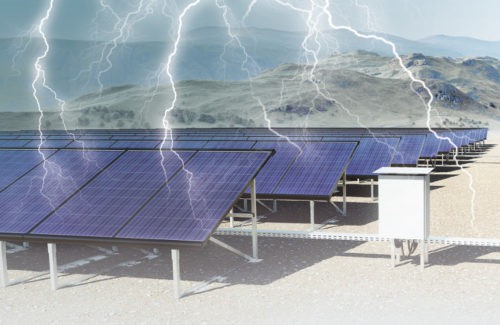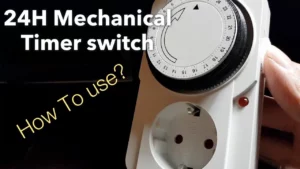Surge protection is essential, and solar panels endure their authorized lifespan due to their large, exposed location. Lightning strikes can easily damage the sensitive components of photovoltaic equipment. Power surges can quickly cause damage to electrical equipment, and even catastrophic failures may occur. Inverters are very expensive, but in industrial applications, downtime costs and losses are quite expensive. In order to prevent high energy from generating high voltage Damascus through electronic equipment, all conductive tops must be directly grounded, and all wires (such as Ethernet cables, AC mains, etc.) that pass through the system must be connected to the ground with lightning arresters.
You can also use solar DC surge protectors to protect installed sensitive electronic equipment, such as computers, TVs, washing machines, and safety circuits, such as fire detection systems and emergency lighting. Transient overvoltage can cause damage to equipment with sensitive electronic circuits.
1. How will the surge affect the system?
The effects of electrical surges may cause immediate failure or long-term damage to the equipment. In order to retain the electrical system’s reliability, the SPD is typically installed on the consumer unit. In addition, other types of surge protection devices can be used to protect the installation from other incoming services. These services include telephone lines and cable television. It is important to realize that only ensuring the electrical installation, not other services, can allow transient voltage to penetrate into the system through another channel.
2. Types pf Surge protection devices
Install a type 1 lightning arrester at the power source (such as the main switchboard). On the sub-distribution board, you can place type 2 spd. (Combination types 1 and 2 spd are available, and people usually use it in consumer units.)
Close to the protected load, type 3 lightning arrester can be fixed. You can combine the solar system with Type 2 lightning arrester. In addition, when multiple devices are needed to protect the installation, the multiple devices must be coordinated to ensure normal operation.
Alion Electric is one of the largest electrical appliance manufacturers in China. All lightning protection devices produced by Gaia are strictly implemented in accordance with the production process and international regulations. ALION has detailed files to ensure that there are no errors in the development, production, acceptance and sales of lightning protection equipment.
3. Selection of solar surge protection devices
Photovoltaic systems have obvious characteristics and need to use SPDs specially designed for photovoltaic systems.
These photovoltaic systems utilize high system voltages of up to 1500 volts. The maximum power point is only a small fraction below the percentile of the system circuit current. In order to choose the correct SPD model for your photovoltaic system, you need to know the following:
- SPD system working temperature;
- The voltage of the system;
- SPD system short-circuit rating;
- The level of the waveform to be prevented;
- SPD minimum discharge current.
When installing lightning protection equipment, you must understand the protection function of the external lightning protection system (LPS). The specified level of LPS determines whether the separation distance between isolation and non-isolation separates LPS and PV installations. The voltage protection level must be 20% lower than the dielectric strength of the terminal equipment to protect it. The key is to use SPD equipment to withstand currents that may be greater than the short-circuit current of the solar array string.
Risk Assessment
Risk assessment is a time-consuming and difficult process. First consider which places are the most vulnerable and which places are the least vulnerable. Then consider the SPD that best suits the type of building you plan to protect (if it has a single service entry switch). Lightning hit 90% of the earth. The most lightning strikes are on tropical land. There is basically no lightning in the North and South Pole, followed by the ocean, with only 0.1 to 1 lightning per square kilometer/year. Even if combat density (Ng) does not seem to be an issue, many countries, such as France, include Ng in their national standard NF C 15-100.
Protection of lightning protection devices
Although SPDs will not be tripped, the following events are likely to end their lives:
Due to the continuous excessive limitation of SPD, preventing thermal runaway caused by exceeding lightning characteristics may gradually damage internal components. The thermal fuse inside the surge protector provides the disconnect function of the surge protector.
When the distribution network fault is less than 50hz or exceeds the maximum flow (such as the neutral point is broken, the neutral point is opposite), a short circuit will occur. You can use a circuit breaker or an external or built-in short-circuit protection device (such as a circuit breaker) to disconnect the lightning arrester.
Even though you may have to choose an external circuit breaker, more and more manufacturers include them in the same enclosure.
When selecting a circuit breaker, the short-circuit current of the building where the lightning arrester is located must be considered. For example, a circuit breaker with a short-circuit breaking current of less than 6kA is suitable for domestic structures. But for the office, it is generally 15kA or 20kA.
However, determining matching is a tricky task; several factors (breaking capacity, lightning resistance current, coordination with upstream protection) must be considered when selecting external short-circuit protection.
4. Conclusion
Choosing the right surge protection device for solar applications is a difficult task. This article aims to help you understand what SPDs are, how they work and why they are necessary for photovoltaic systems. When choosing a suitable surge protection device model, the most important thing to remember is that it is not only to protect your system from voltage shocks or power spikes; it is also related to preventing damage caused by overvoltage (overvoltage occurrence). Above the level that can cause voltage peaks).
If you are not sure about any aspect of this process, or if you just want to help you choose the perfect SPD model, please contact us today so that we can provide you with comprehensive guidance to help you find the perfect SPD model for your needs SPD model.










